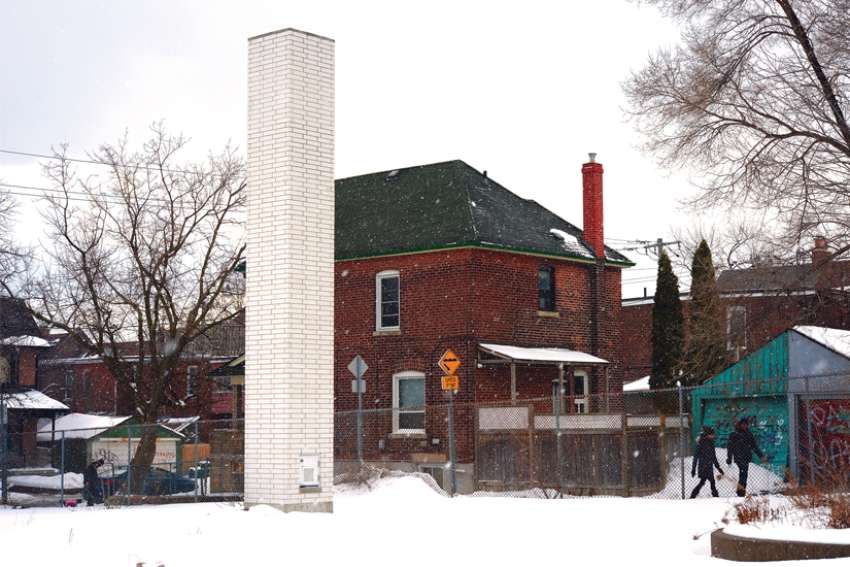Located near Christie Pits in midtown Toronto, the structure was erected by Kohn Shnier Architects as a replacement habitat for chimney swifts — little birds that are dwindling in number which once inhabited the chimney of the former school. Designated a “threatened” species in Ontario, chimney swifts are at serious risk of becoming endangered due to the nation’s changing architectural landscape.
“I don’t think we’ve been asked about a project more and it’s our smallest and simplest,” laughed Martin Shnier, partner at Kohn Shnier Architects which was commissioned by the Toronto Catholic District School Board to build a new school on the property. “We’re pleased it worked out. It also gave us a chance to test out the brick we’re going to use on the school which was a nice thing to be able to do. When the school is built there will be a plaque put up explaining the tower so the kids will learn something about it.”
Traditionally chimney swifts nested in cave walls and hollow trees but today they are more likely to be found in urban areas where they nest in chimneys and other architectural structures. The birds are experiencing an ongoing loss of roosting or nesting sites as a result of demolition or modification of chimneys and other structures, as well as human use of chimneys during the nesting period.
Ontario legislation in place says if a building is to be torn down it has to be inspected for evidence of chimney swifts. If evidence of occupancy is found, an alternative habitat must be built for the demolition to proceed.
Part of the provincial regulation is that after a habitat is built, the structure must be inspected once a year for five years and a report made. If confirmed to be active over time, the habitats become permanent. The second report completed in March confirmed that there is a nest in the chimney and evidence of occupation. When the birds arrive in the spring they swarm en masse and over time a pair will nest becoming the home to a new generation of birds.
Working with a consultant, Shnier and his team were advised to build the structure as far from trees and from the new construction on the property as possible. They were given the advisable height and dimensions and mortar drains were left uncleaned and rough creating the ideal surface needed for the birds to perch and nest. With brick on the outside and concrete block on the inside the habitat also includes a layer of insulation to combat temperature fluctuations. A tiny door at the base of the tower is used for inspections, which has confirmed chimney swifts are occupying the new structure.
“The information that we have is that 50 of these (habitats) have been built (in Ontario) under this legislation since it began but only two of them have been occupied,” said Shnier. “One of them is the one on the St. Raymond site. So we’re happy about that.”
“It is rewarding to have re-established a functioning nesting location,” said Shirley Sederavicius, TCDSB project supervisor for the new school that is scheduled to be ready for occupancy in January 2024. “In the two nesting seasons that have occurred since this chimney was built, we have seen an increase in usage and look forward to a continued and hopefully increasing habitation by the chimney swift.”
The medium-sized, soot-gray bird with long, slender wings and short legs is suited to cling to vertical surfaces. Though birds are typically considered an architectural nuisance, Schnier says there is a growing shift in consciousness and recognition of their importance and value.
The habitat attempts to heal some of the wounds architects have created in the destruction of habitats, both natural and man-made. It envisions a future where human and non-human life forms can cohabitate in a more balanced ecosystem.
Though unexpected, Shnier is happy to know the simple project is helping to save the species in the province.
“After the review period of five years, it just stays there,” said Shnier. “Hopefully it continues to be occupied and add a few swift each year to the population.”


